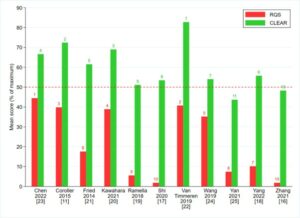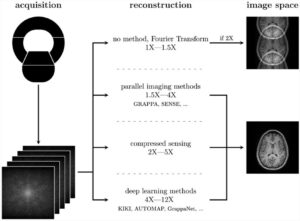Given the buzz around artificial intelligence (AI) in the field of radiology, it is only natural that publications, like scientific journals, and other forms of media, are being created and/or evolving in order to serve this growing trend. One only has to perform a simple Google search in order to see the amount of organizations, companies, and individuals that appear throughout this new landscape.
Although the spectrum of disciplines within the field of radiology is quite expansive, some particular areas are receiving more attention than others regarding scientific publications, according to Professor Charles Kahn from the University of Pennsylvania and Editor-in-Chief of the RSNA’s new online journal, Radiology: Artificial Intelligence. “It takes a lot of work to have a really strong scientific study. You have to have the data set, the algorithms, and you have to do the analysis,” says Kahn. “These just happen to be the areas that people have worked in.” The disciplines Kahn speaks of include musculoskeletal radiology and neuroradiology, among others. Part of the reason for this is that the aforementioned organizations, companies, and individuals creating the technology and doing the research are focusing on areas where they see the greatest potential impact. Kahn states that people focus on these particular disciplines because they are comprised of some of the most commonly performed procedures, such as chest radiographs.
In addition to scientific papers on AI and their focus on the above-mentioned disciplines, there is also an interest within the radiological community on the topic of education. “We’re interested in papers that either focus on educating radiologists about AI technologies, or about the use of AI in education,” says Kahn.
Publishing in the field of AI
 Radiology: Artificial Intelligence is one of the many responses in the world of radiology to a shift in focus to AI. Because AI is a multi-disciplinary field, an important aspect of interest is the composition of the Editorial Board and reviewer pool. “All four of the journal’s deputy editors are active in scientific research related to radiology AI. Two of them are directors of laboratories of machine learning; one is an imaging informatics scientist and does a lot of work in information integration and radiomics; and one is a musculoskeletal radiologist and a statistical geneticist.” Kahn states that, because no one is an expert in everything, it is important to cover all your bases. “We’re fortunate to have a tremendous breadth of expertise among the members of our editorial board – physicians and scientists with knowledge of the various subspecialties of radiology and of the many different types of machine learning.” Thus, their reviewer pool also consists of individuals with backgrounds in areas like machine learning, convolutional neural networks, and computer science. In order to adapt to the ever-changing landscape of radiology, the scientific and academic side must also evolve with it.
Radiology: Artificial Intelligence is one of the many responses in the world of radiology to a shift in focus to AI. Because AI is a multi-disciplinary field, an important aspect of interest is the composition of the Editorial Board and reviewer pool. “All four of the journal’s deputy editors are active in scientific research related to radiology AI. Two of them are directors of laboratories of machine learning; one is an imaging informatics scientist and does a lot of work in information integration and radiomics; and one is a musculoskeletal radiologist and a statistical geneticist.” Kahn states that, because no one is an expert in everything, it is important to cover all your bases. “We’re fortunate to have a tremendous breadth of expertise among the members of our editorial board – physicians and scientists with knowledge of the various subspecialties of radiology and of the many different types of machine learning.” Thus, their reviewer pool also consists of individuals with backgrounds in areas like machine learning, convolutional neural networks, and computer science. In order to adapt to the ever-changing landscape of radiology, the scientific and academic side must also evolve with it.
A topic of interest that has risen from this new focus on AI within scientific publications is that of data sharing and open research. “There’s a lot of interest among scientific journals in not only making the results of research open but having the data and the algorithms be available, as well,” says Kahn. “Increasingly, the algorithms that people use to build these tools and all these different architectures are available through the Web.” The basic conception and structure of journal articles on AI has remained relatively similar, however, there has been a shift in the main component around which the articles are built.
“Traditionally, it was the software – the algorithms – that represented the researchers’ intellectual contribution. So, that was the intellectual property that they might wish to protect. Now, with machine learning, the algorithms are available publically. The data have become the key ingredient to build their models. Investigators may hesitate to share their data to protect patient privacy and to protect their own intellectual property.”
On the subject of submitting articles to scientific journals, an important issue is the use of the “Standards for Reporting Diagnostic accuracy studies” guidelines, or STARD. According to Cohen et al., these guidelines were developed in order to “improve the completeness and transparency of reports of diagnostic accuracy studies” [1]. Kahn posits, “STARD provides a guideline to write a paper, and to review a paper; the guideline defines the elements that need to be included.” Basically, in this new territory of AI-focused articles, Kahn would like to see a version of the STARD guidelines, but including the topic of AI. “We feel very strongly that there are particular things we have to look at in regard to AI papers,” states Kahn. “It’s like STARD with a couple of other things to make sure there are some criteria for how people begin to think about this.”
Through the founding of AI-focused journals, new reporting guidelines, article structure, and topic trends, one can presume that the growth of AI in radiology and healthcare will surely impact the industry landscape.
Stay tuned for Part II of our interview with Professor Charles Kahn, in which we will dive into his thoughts on the future of artificial intelligence in radiology, education in radiology, and the ethical and legal implications of these emerging technologies.
Thank you to Charles Kahn, professor and vice chairman of radiology at Perelman School of Medicine and senior fellow of the Institute for Biomedical Informatics and the Leonard Davis Institute of Health Economics at University of Pennsylvania, for taking the time for our interview at ECR 2019 in Vienna, Austria.
1. Stard 2015 Guidelines For Reporting Diagnostic Accuracy Studies: Explanation and Elaboration
Jérémie Cohen-Daniël Korevaar-Douglas Altman-David Bruns-Constantine Gatsonis-Lotty Hooft-Les Irwig-Deborah Levine-Johannes Reitsma-Henrica de Vet-Patrick Bossuyt – https://www.ncbi.nlm.nih.gov/pubmed/28137831













